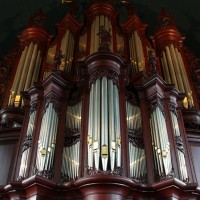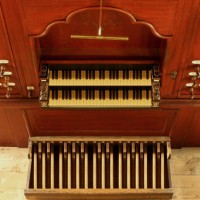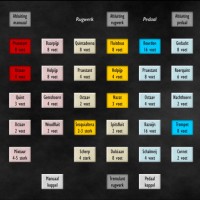The pipe organ composed of 33 stops located in the Midwolda Reformed church is the largest instrument built by Albertus Antony “Hints” in the province of Groningen. The unusual spelling of the name of the organbuilder commonly known as Hinsz is found on the plaque above the organ console. The organ is one of his late works, distinguished by a fundamental oriented sound. The mixture is high pitched in bass, but sounds dark in the treble due to a tierce rank and 16 feet foundation. It was intended to support congregational singing, together with the cornet. Both manuals have a complete flute choir. The HW Praestant 8′ has two unisono ranks in treble. The pedal is completely stand alone, containing a full reed chorus (16′, 8′, 4′, 2′), but lacking a Pedal Mixture.
The organ was delivered by the builder in 1772. Immediately it became famous and praised among contemporaries as Joachim Hess testified. Nevertheless, the instrument was subject to various alterations during its history. Hermann Eberhard Freytag added a pedal coupler in 1834, and replaced the RW Scherp with a Fluit-Travers. In 1897, Petrus van Oeckelen added a Gamba, removed tierce ranks, repitched the organ to 440 Hz (the original Hints pitch was 415 Hz) by shortening pipes, wind pressure was raised considerably. Flentrop company performed a restoration of the instrument in 1970-72, although it retained many elements introduced by van Oeckelen, including the non-original pitch of the instrument. However, the tierce ranks were restored (HW Mixture and RW Sesquialtera) and the RW Scherp was reconstructed. Nowadays, the pitch of the organ has been lowered slightly, it was about 434 Hz when recorded by Sonus Paradisi, and an uneven temperament similar to Valotti-Young was introduced. The organ is valuable for a high amount (95%) of original Hints pipes.
The sampleset can be ordered in our webshop. Click here for the link.




